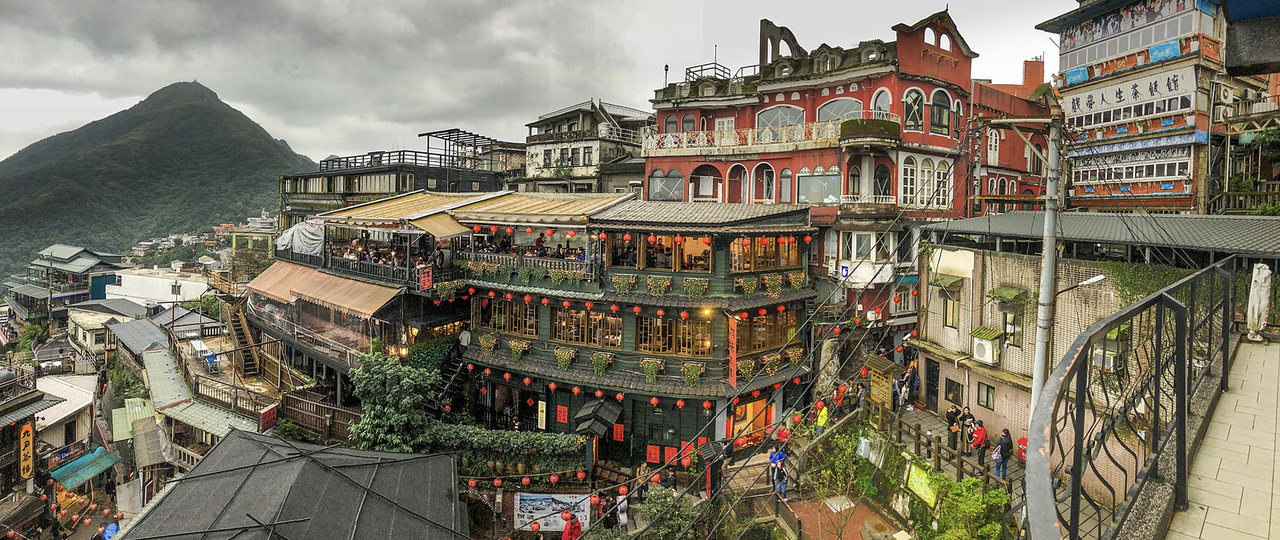The Layered City of Jiufen
View FullscreenThe Layered City of Jiufen

Jiufen, Taiwan, Qing dynasty to present (Photo by Gregg Tavares)
The city of Jiufen, located on the northeastern tip of Taiwan, demonstrates its history through layers depicting its shift in purpose, economy, and significance. Founded during the Qing dynasty (1636-1911) Jiufen was a small village built on the coastal hills of Taiwan’s countryside(1). Jiufen’s name means “nine portions” in Chinese as the village first inhabited 9 families. When ships would come with goods, the name signified that they would need nine portions. The village remained rural and agrarian up until the 1890s when gold was discovered in the nearby Keelung river. During the Japanese colonial occupation of Taiwan, Jiufen became a popular mining site for the Japanese gold rush era. As word spread about Jiufen’s prosperous location people began flooding the village. Space was limited due to its mountainous location which was prone to landslides and aggressive typhoons so to accommodate the mass influx in population the village was established upwards(2). More buildings emerged in the limited gaps between the present buildings and the existing buildings were built upwards. The small agrarian village soon became a site of post modern industrialism.
In WWII, Jiufen housed the Japanese prisoner of war camp (POW) Formosa. The prisoners of war, which mainly consisted of British soldiers, were sent to work in the Kinkaseki gold mine. Their treatment and working conditions were horrific making the Formosa one of the most inhumane POW camps to exist in WWII (5). After WWII, Taiwan was handed over from Japan to China and Jiufen slid into the shadows. The mines closed in 1971 and for the next decade Jiufen remained unmentioned, that is up until 1989 due to Hou Hsiao-Hsein’s film A City of Sadness (4). The film depicts two brothers experiencing life after Taiwan’s handover to China in 1945. The film, despite not being completely historically accurate, was critically acclaimed receiving Taiwan’s first Golden Lion award at the Venice Film Festival (3)(6). Jiufen was suddenly brought back into public life as it became a famous cinematic tourist site. With another flood of people coming into the city, Jiufen once again adapted to account for the shift in population. The film drove a shift in Jiufen’s economy from a post-industrial mining economy to a tourist economy. Facing the same geomantic factors, the city continued to build upwards. Tea houses, souvenir shops, and other tourist directed structures were built and historic structures were reconstructed to allow for visitation. More films emerged either being based in Jiufen or reflecting similar architecture as its juxtaposition of a rural agrarian site, to a post modern industrialist society, and finally to a booming tourist city made for a unique setting full of symbolic potential.
This neatline explores Jiufen’s unique intersection of its history seen through its architecture. The waypoints depicted call to various aspects of its history and its unique ability to adapt through continual change. Going through various economic shifts, handovers between Japanese and Chinese occupation, negative historic significance with the Formosa POW camp, and its location being prone to the effects of typhoon season and landslides, Jiufen continues to wear its layered history with pride.
1. Wu, Hung Che and Cheng, Ching Chan “An Empirical Analysis of Tourists’ Switching Intention: The Case of Jiufen”, Journal of China Tourism Research, 14:2, 193-220, 2018 DOI: 10.1080/19388160.2018.1463883.
2. Hung, Chih-wen. 2013. “A 300-Year Typhoon Record in Taiwan and the Relationship with Solar Activity.” Terrestrial, Atmospheric and Oceanic Sciences 24 (4–2): 737. https://doi.org/10.3319/tao.2013.02.18.01(a).
3. Lo, Dennis. “A Home in Becoming: Forging Taiwan’s Imagined Community in Jiufen.” In The Authorship of Place: A Cultural Geography of the New Chinese Cinemas, 1st ed., 98–118. Hong Kong University Press, 2020. DOI: https://doi.org/10.2307/j.ctv1g13js8.9.
4. Shih, Naai-Jung and Lin, Chen-Yang. “The evolving urban fabric and contour of old mountain streets in Taiwan”, Tourism Geographies, 2017. DOI: 10.1080/14616688.2017.1388437.
5. Ramasastry, Anita. “Corporate Complicity: From Nuremberg to Rangoon - An Examination of Forced Labor Cases and Their Impact on the Liability of Multinational Corporations.” B. Trials of Other Industrialists: Japanese Mining Company Officials and the Kinkaseki Mine Prosecutions 20, no. 1, 113–17, 2002. DOI: https://doi.org/https://doi.org/10.15779/Z388921.
6. Chen, Lung-chu. 2016. “The Nationalist Chinese Military Occupation (1945 to 1949) Section III Subsection B.” The U.S.-Taiwan-China Relationship in International Law and Policy. https://doi.org/10.1093/acprof:oso/9780190601126.003.0001.